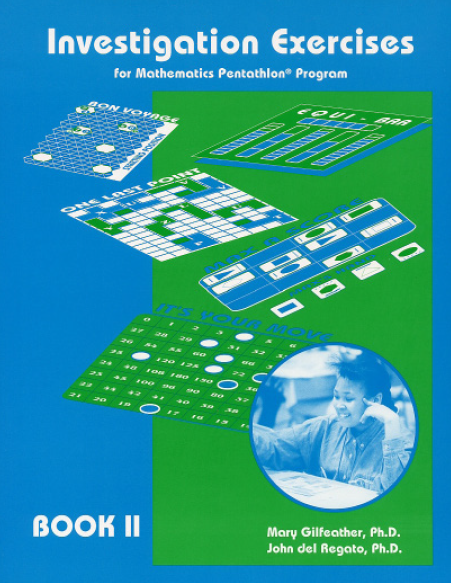THE GAMES & ESSENTIAL RESOURCES
The Mathematics Pentathlon® Program is organized by Grade Level into 4 Divisions. Within each Division there are 5 Problem-Solving Games and related Resources that deal with a broad spectrum of mathematical thought. Division I was designed for Grades K-1, Division II for Grades 2-3, Division III for Grades 4-5, and Division IV for Grades 6-7.
To share this information with your faculty or parents,
download this Division or all Divisions Description Sheets
Game Description Sheet – Division III (4 – 5)
Game Description Sheets – Div I, II, III & IV (K – 7)
THE GAMES
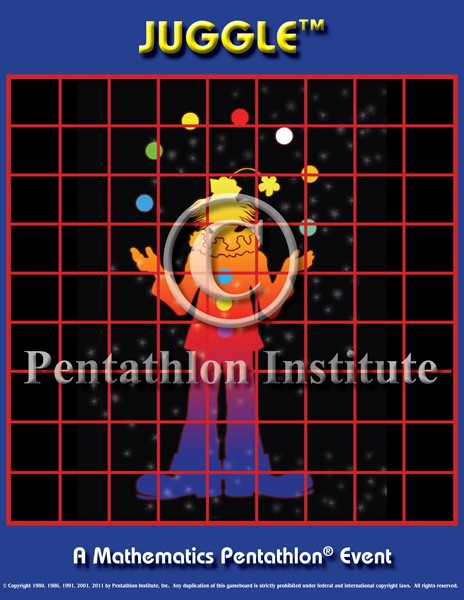 JUGGLE™
JUGGLE™
In this game players “juggle” polyominoes in order to be the first to complete their 9 x 9 grid-like gameboards. The roll of two dice determines which pieces are selected from 5 different types of polyominoes, including pentominoes and tetrominoes. In the process of playing the game students develop a deeper understanding of mathematical relationships involving area, perimeter, and transformational geometry (flips/reflections, turns/rotations, and slides/translations). Spatial and logical reasoning skills are enhanced as students try to balance probability and chance, as well as structural relationships.
![]() CONTIG 60™
CONTIG 60™
The four basic operations (addition, subtraction, multiplication, and division), probability, and algebraic thinking are integrated in this strategy-chance game. Numerical values are arranged in a particular pattern on the gameboard. For each play students form a number sentence based on the roll of 3 regular dice and place chips on a corresponding numbered space. Arranging 5 chips along contiguous horizontal, vertical, or diagonal lines relates to one goal of the game. A second goal pertains to scoring and connected chip placement. By playing this game students practice basic skills in a highly motivational format that also enhances their problem-solving and computational reasoning abilities.
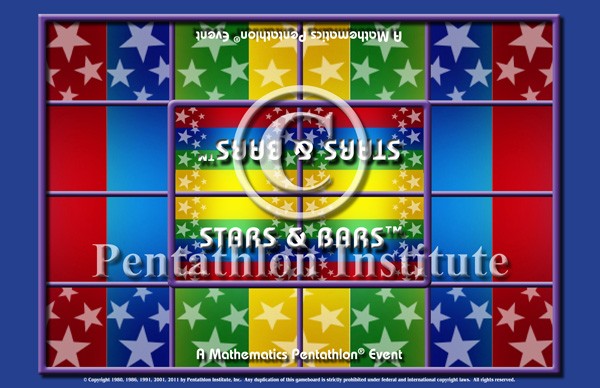 STARS & BARS™
STARS & BARS™
This multiple classification-logic game uses geometric attribute cards and a grid-type board to help students develop understanding of multi-variable relationships and algebraic principles. For each play students try to maximize their scores by placing cards onto the gameboard and comparing them to adjacent cards that are one, two, three, or four-ways different. The horizontal, vertical, and diagonal placement of the cards onto the gameboard contributes to the development of logical, computational, and spatial thought.
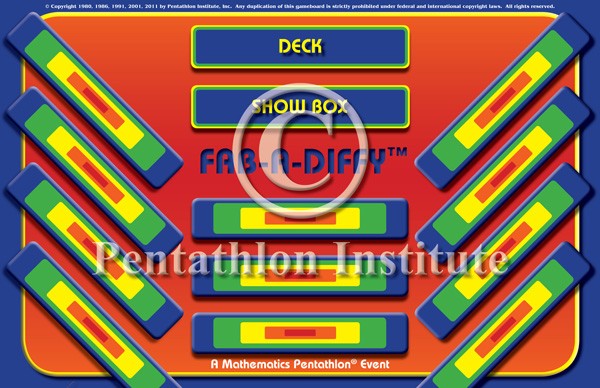 FAB-A-DIFFY™
FAB-A-DIFFY™
Fraction bars that pictorially represent various fraction values are used in this computational reasoning game. In playing this game students attempt to make arithmetic combinations on the specially designed gameboard. Conceptual understanding of equivalence and addition and subtraction of fractions as well as algebraic principles are developed while students connect symbolic procedures with visual models.
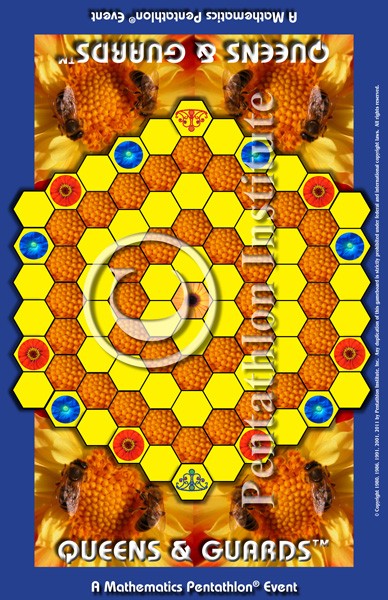 QUEENS & GUARDS™
QUEENS & GUARDS™
This spatial reasoning game combines the simplicity of rules found in Checkers with the complexity of strategy experienced in Chess. A gameboard of tessellated hexagons that form concentric bands and pawns (queens) and chips (guards) are used to simulate the agonistic pattern of bees in a beehive. By learning how to construct a variety of triangular and other structural arrangements on the gameboard, students develop spatial thinking as well as many other logical reasoning skills, including deductive and inductive thought.
THE ESSENTIAL RESOURCES

The Rule Manual for Mathematics Pentathlon Problem Solving Games Division III (Grades 4-5) is a Full-Color publication that provides the Official Rules for each of the 5 Mathematics Pentathlon Games including: Background/History of the Game, Materials, Goal, How to Start the Game, Underlying Math/Science, Basic Rules, and Game Specific Tournament Rules. This detailed Manual also illustrates and describes the recommended Team Grouping for Cooperative Learning and Good Sportsmanship. In addition, a detailed Introduction defines Active Problem Solving and the many critical characteristics and philosophy of the Math Pentathlon Program. A Math Content & Standards Chart for the entire Math Pentathlon Program is outlined on the Inside Back Cover.
The Guide for Teaching and Sequencing the Mathematics Pentathlon Program Division III (Grades 4-5) is a Full-Color step-by-step Teaching Guide that coordinates the Program’s three key resources: the Games and Rule Manual, the Adventures in Problem Solving Book II, and the Investigation Exercises Binder II. Organized into Monthly Lesson Plans each Guide outlines four lessons per month for weekly implementation. Each lesson describes necessary materials, approximate lesson time, resources with corresponding page numbers, and a summary of each activity with related illustrations.
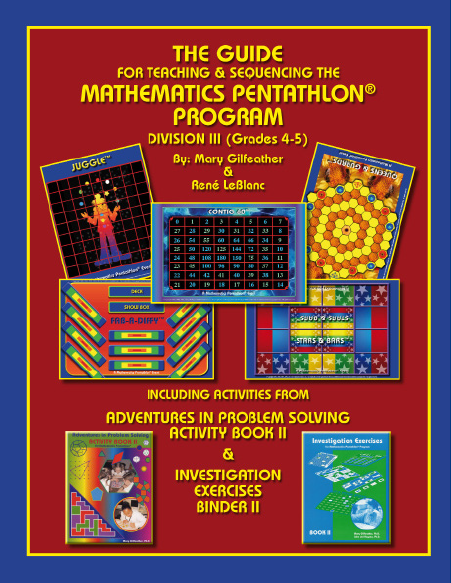
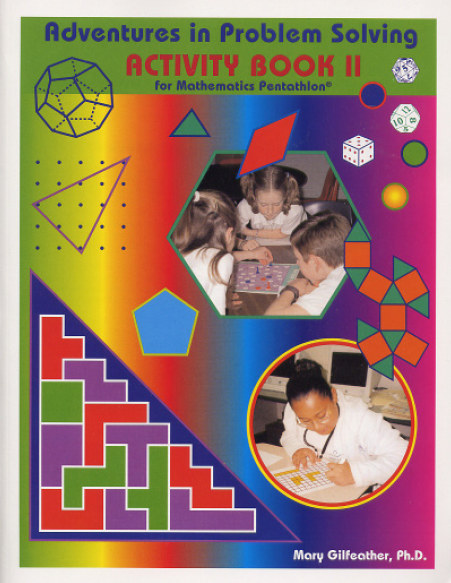
Adventures in Problem Solving Activity Book II (Grades 4-7) links the Mathematics Pentathlon® series of games with the mathematics curriculum. The numerous activities and projects described in this book guide teachers/coaches to explore with their students important geometric, numerical, and scientific relationships. This publication also helps teachers to coordinate the games with mathematics content/process objectives. In addition, many introductory activities are described that develop prerequisite skills for being successful in playing the Mathematics Pentathlon® games and developing related problem-solving strategies. Both the Mathematics Pentathlon® Games and Adventures in Problem Solving Book II activities make use of a wide variety of concrete and pictorial models that help students understand and remember important mathematical concepts.
Investigation Exercises Book II (Grades 4-7) is the assessment resource for the Mathematics Pentathlon®Program . For many years educational leaders have advocated the use of assessment instruments that go beyond the minimal expectancies of standardized testing procedures. Such conventional instruments evaluate students’ ability to memorize information in unrelated situations. When teachers “teach to the test” students often use only short-term memory tactics to cope. The Mathematics Pentathlon® Games require a dynamic form of thinking that cannot be assessed with conventional instruments. Investigation Exercises Book II complements the Mathematics Pentathlon® games and Adventures in Problem Solving activities by providing numerous nonconventional paper-pencil ideas for assessing students’ understanding of mathematical relationships/skills that directly relate to the games/activities. This publication also encourages students to critically examine various game-playing options and choose strategic moves.
